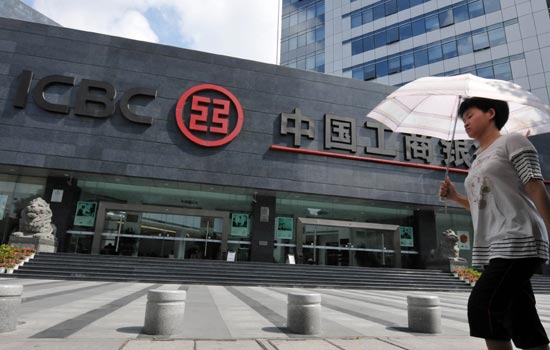Banks' NPL figures 'don't add up'
Updated: 2012-06-05 09:08
By Wang Xiaotian (China Daily)
|
|||||||||||
|
 |
|
A woman walks past an Industrial and Commercial Bank of China Ltd office in Fuzhou, Fujian province. The country's banking regulator is inspecting major State-owned banks for inconsistencies between a surge in some categories of problematic loans and a decline in non-performing loan ratios. [Photo/China Daily] |
Industry regulator checking loan classification for potential risks
China's banking regulator has noticed a contradiction between a surge in some categories of problematic loans on the one hand and a decline in non-performing loan ratios on the other over the past few months, and it is taking a closer look at lenders' loan classification, said a senior official on Monday.
"We are already aware of an obvious increase in overdue loans and 'special-mention' loans. Further statistics and analysis are necessary for us to discover the cause of the inconsistency and how much hidden risk there is," said the source from the China Banking Regulatory Commission, who declined to be identified.
"But generally speaking, the inconsistency is not very large, and the risks of rising bad loans are still controllable," the source said.
Chinese banks follow the international five-category system that classifies loans as "pass", "special-mention", "substandard", "doubtful" and "loss", in line with their inherent risks. The last three groups are regarded as non-performing loans.
The CBRC has ordered major State-owned lenders to assess their loan quality as economic growth slows and more loans turn sour, the Shanghai-based China Business News reported on Monday.
The regulator ordered the top five lenders - Industrial and Commercial Bank of China Ltd, China Construction Bank Corp, Bank of China Ltd, Agricultural Bank of China Ltd and Bank of Communications Co Ltd - to examine the classification of all their loans as of the end of last year, the newspaper reported, citing an anonymous source.
It reported that the results of this examination had been submitted to the CBRC at the end of last month.
The order was actually issued by the CBRC at the beginning of this year, another source from the banking regulator told China Daily. This source said that the commission will comb through and summarize materials submitted by the lenders, but the results are unlikely to be released.
Yan Qingmin, assistant chairman of the CBRC, said earlier that the regulator is tightening the reins on the classification of loans among commercial banks. The regulator expects that, by taking this action, credit risks generated as a result of large-scale lending during the financial crisis to shore up the economy could be contained.
The five lenders' outstanding loans exceeded 28 trillion yuan ($4.4 trillion) at the end of last year, while their NPLs totaled 316 billion yuan.
"The examination of the authenticity and accuracy of the classifications aims to expose credit risks and reflects regulators' worries over loan quality," China Business News cited its source as saying.
Commercial banks' outstanding NPLs increased for a second quarter during the first three months of the year, the first such sequential rise since 2005, according to CBRC data.
At the end of March, bad loans stood at 438.2 billion yuan, up 10.3 billion yuan from three months earlier. The NPL ratio narrowed to 0.9 percent, from 1 percent in December.
China's problematic loans are "vastly understated" and banks' cushions are "thinning as deposit growth slows and forbearance reduces loan repayments", Fitch Ratings said earlier.
Total loan loss reserves among lenders reached 1.26 trillion yuan at the end of March.
Banks should make more effort to write off bad assets while the favorable condition of high provisions remains, said CBRC Chairman Shang Fulin at the end of last year.
Yvonne Zhang, vice-president and senior analyst at Moody's Investors Service (Beijing) Ltd, said banks are at the beginning of a rising NPL cycle, but the NPL ratios they report to the regulator and the public might not be accurate.
"Compared with last year, overdue loans and 'special-mention' loans have been increasing very noticeably, especially among some small and medium-sized lenders, but the increases were not reflected in their NPL ratio."
Zhang said subjective judgment usually enters into the calculation of NPLs, as banks use different classifications and definition criteria.
"When overall loan quality is deteriorating, the trend for overdue loans and NPL ratios should be the same."
According to the results of Moody's two bank stress tests covering the next 18 months, the impact of deteriorating asset quality among banks would be well contained if GDP growth slowed to about 7 percent, with the NPL ratio rising to 6 to 9 percent.
But if economic growth is only 4 or 5 percent, the banking system would be in trouble, as the NPL ratio would surge to as high as 20 percent.
wangxiaotian@chinadaily.com.cn
Related Stories
China authorizes loan-backed securities 2012-06-04 15:24
China's lenders ordered to check bad loans 2012-06-04 15:14
Loan exchange may forge a way out 2012-05-31 11:13
Capital city lays plans for more loan support 2012-05-25 08:20
Guangdong firms to apply for yuan loans in HK 2012-05-17 10:42
Demand for loans remains weak 2012-05-16 14:12
Today's Top News
President Xi confident in recovery from quake
H7N9 update: 104 cases, 21 deaths
Telecom workers restore links
Coal mine blast kills 18 in Jilin
Intl scholarship puts China on the map
More bird flu patients discharged
Gold loses sheen, but still a safe bet
US 'turns blind eye to human rights'
Hot Topics
Lunar probe , China growth forecasts, Emission rules get tougher, China seen through 'colored lens', International board,
Editor's Picks

|

|

|

|

|

|





